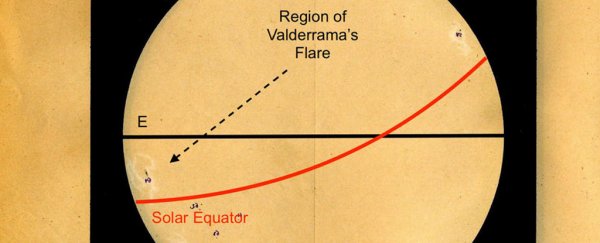If you've never heard of Juan Valderrama y Aguilar, you're not alone. As it turns out, this amateur astronomer from Spain made history when he was just 17 years old.
Back in 1886, Valderrama observed the third-ever recorded instance of an exceptionally bright solar flare, and even got his results published in an academic journal. But due to historical circumstance, we're only hearing about this more than 100 years after his death.
There's plenty of turbulent magnetic activity happening on the surface of our Sun. Concentration of that energy can cause dark sunspots, characterised by a dip in the surface temperature. And when that magnetic energy suddenly explodes, we get fantastic solar flares.
Despite risking damage to their retinas, humans have been watching sunspots for hundreds of years, but it wasn't until 1859 - more than 200 years after the advent of the telescope - when English astronomer Richard Carrington lucked out and became the first human in history to observe a solar flare.
The following solar storm was the biggest one recorded to this day - and if it were to happen today, it would wipe out a great deal of our communications technology.
Thirteen years later, Italian astronomer Pietro Angelo Secchi scored a glimpse at a solar flare as well, thus joining Carrington's extremely exclusive club.
The third man to set his eyes on this remarkable sight was an unknown teen from Madrid, Spain. Unlike the fancy astronomers before him, all Valderrama had was a small backyard telescope with an aperture of just 6.6 centimetres (2.6 inches) and a strong filter to allow a look at the Sun.
He kept detailed logs of his sunspot observations. And then on 10 September 1886, his amateur efforts were rewarded with something truly spectacular.
"In the eastern region of the southern hemisphere a huge, beautiful sunspot was formed from yesterday to today," he wrote in his logbook.
"By looking at it carefully I noticed an extraordinary phenomenon on her, on the penumbra to the west of the nucleus, and almost in contact with it, a very bright object was distinguishable, producing a shadow clearly visible on the sunspot penumbra.
"This object had an almost circular shape, and a light beam came out from its eastern part that crossed the sunspot to the south of the nucleus."
Astonished by the bright flash he'd seen, Valderrama captured the details in a meticulous drawing, and sent the information to an academic journal in France, L'Astronomie.
 Valderrama's drawing. (Vaquero et al., Sol Phys 2017)
Valderrama's drawing. (Vaquero et al., Sol Phys 2017)
But despite earning this publication, his achievement was lost in the annals of history and we probably still wouldn't know about it, if a team of Spanish researchers hadn't been researching historical records of solar observations.
"The case of Valderrama is very unique, as he was the only person in the world more than a century ago to observe a relatively rare phenomenon: a white-light solar flare. And until now no one had realised," says one of the team, José Manuel Vaquero from the University of Extremadura in Spain.
Back then, these white-light flares were considered exceptional, and it's only with the advent of modern, much more sensitive telescopes that we know that most solar flares are actually accompanied with such bright emissions of light.
"It is extraordinary that in the Spain of the 19th century, a 17-year old kid would make such a scientific discovery, and it is even more impressive that he had the courage of submitting it for publication to a foreign scientific journal," says one of the researchers, Jorge Sánchez Almeida from the Instituto de Astrofísica de Canarias (IAC) in Spain.
 Photo from Ogyalla observatory dating to 10 Sept 1886, marked up by researchers to show the flare. (Vaquero et al, Sol Phys 2017)
Photo from Ogyalla observatory dating to 10 Sept 1886, marked up by researchers to show the flare. (Vaquero et al, Sol Phys 2017)
Valderrama's logbooks, spanning observations from December 1885 to April 1888, were preserved at the library of IAC, but very little is known about his life.
According to Almeida's personal website, the team is currently working on publishing a biography of Valderrama. "Who was this guy? If you are interested … stay tuned," writes Almeida.
We're certainly interested.
The findings were published in Solar Physics earlier this year.
